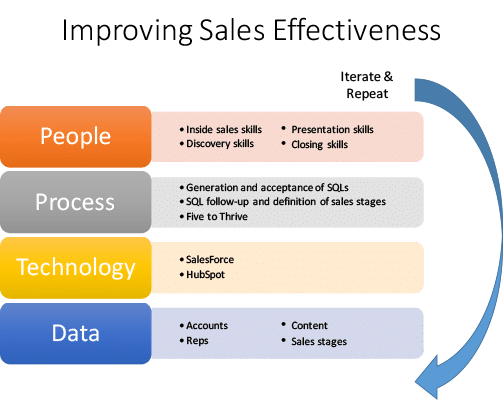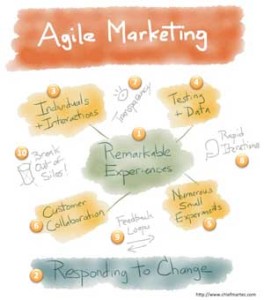I love Scott Brinker’s Chief Marketing Technologist blog. Not many people know this, but a blog post by Scott in 2010 was the inspiration for this blog. I constantly find that Scott produces thoughtful, well written content. The latest post on his blog, by guest writer Sam Melnik, is a great example of this kind of inspiring and thoughtful content.
The post is titled “Don’t buy marketing technologies, build layers instead”, and the key paragraph for me was this statement:
Don’t buy point solutions or marketing technologies in a vacuum. Instead, build capability layers into your marketing organization and organize marketing technologies in the context of those layers and the actions they need to perform.
I think that’s exactly right. Build marketing capability layers. This is part of what I was trying to articulate in my article about organizing an Agile Marketing team.
Sam makes another important point:
The marketing organization and the sets of layers should revolve around four factors: people, process, technologies, and data.
Those four factors are incredibly important. To be successful, you have to hire and develop the right people, you have to put in place the right processes, you have to select the right marketing technologies and you have to collect and maintain the right data to make decisions and to determine the effectiveness of your marketing efforts.
At the end of the article, Sam asks the question “what sets of layers you are building in your marketing organization?” I’d like to describe a few of the layers we built at InDemand Interpreting, my last company, and what we learned in building these marketing capability layers.
Improving Sales Effectiveness
This is one of the layers of capability that Sam describes, and it’s a critical component of any B2B marketing organization. Here’s my diagram, broken up into the four factors of people, process, technologies and data:
 If you study Sam’s diagram of improving sales effectiveness, I’ve taken a slightly different approach. First, in data I’ve focused on the entities (accounts, reps, content and sales stages). Although it’s not shown in the diagram, I’d also articulate the relationships between these entities (for anyone who has a database background, this could be represented in a classic Entity-Relationship diagram).
If you study Sam’s diagram of improving sales effectiveness, I’ve taken a slightly different approach. First, in data I’ve focused on the entities (accounts, reps, content and sales stages). Although it’s not shown in the diagram, I’d also articulate the relationships between these entities (for anyone who has a database background, this could be represented in a classic Entity-Relationship diagram).
In terms of the technology layer, we used SalesForce and HubSpot as our systems of record.
Process turned out to be the most important aspect of improving our sales effectiveness. Not only did we have to get a common definition of a sales qualified lead (SQL) between our marketing and sales teams, but we also had to define the expectations of how quickly sales was going to follow up on these SQLs. We also got agreement on the stages of the sales cycle. This became a very important part of our forecasting methodology. Rather than asking salespeople to give us their percent confidence that a deal would close in the quarter, we assigned percentages to stages, and defined the stages based on commitments or actions by the customer. Each stage was then assigned a percent confidence factor. This ensured consistency between sales people in forecasting.
We also developed a sales and deployment process we called Five to Thrive, which ended up being part of our competitive advantage.
Lastly, we worked to ensure that people had the right set of skills for sales effectiveness. These skills included having our inside sales folks using certain scripts and talking points, as well s training our outside sales people in discovery, presentation and closing skills.
And as Sam correctly points out in his diagram, establishing this marketing capability is not a one-time thing, but something where you revise and adapt it over time, improving through iteration.
Agility
I think that agility is a marketing capability, and one that marketing organizations have to focus on developing. It doesn’t come for free. Here’s a diagram illustrating our approach to developing agility as a marketing capability.
One of the beauties of scrum is that it allows teams to track their throughput over time. It’s also one of the reasons I love Agile Marketing, because before Agile, most marketing teams couldn’t answer the question about how they’re doing in terms of throughput and getting work done. I also think it’s important to measure how quickly your team is responding to competitive actions, and how quickly they are taking advantage of newsjacking opportunities.
The technologies that you could use to improve your marketing agility are numerous. I’ve listed a few, but most organizations will use many different tools.
Again, the process is probably the most important piece of improving marketing agility. Not only how are you adopting Scrum (and perhaps Kanban), but do you have a formal process for responding to competitors? Do you have a formal process for newsjacking?
Lastly, you need to hire for agility. Let’s face it, some people are more agile than others, and more comfortable responding quickly and changing on the fly. I also think you need to hire people who are metrics driven, and willing to be held accountable to the right kind of metrics.
Other Marketing Capability Layers
I brainstormed a list of other marketing capability layers, but quite frankly, they’re going to vary quite a bit depending on whether you’re a B2B, B2C, eCommerce, SAAS, early stage, growth stage, market leader, or some other kind of marketing organization. Here are some ideas to get you started:
- Improving awareness/generating buzz
- Improving lead generation
- Improving lead nurturing
- Generating effective content
- Improving community engagement, community building
- Improving lifecycle marketing
I’d love to hear what marketing capability layers you are developing in your organization, and how you’re going about it.





You uncovered many unknown facts related to the marketing. Till now what I have seen works for many is agile one but also depends on ones’ business objectives.